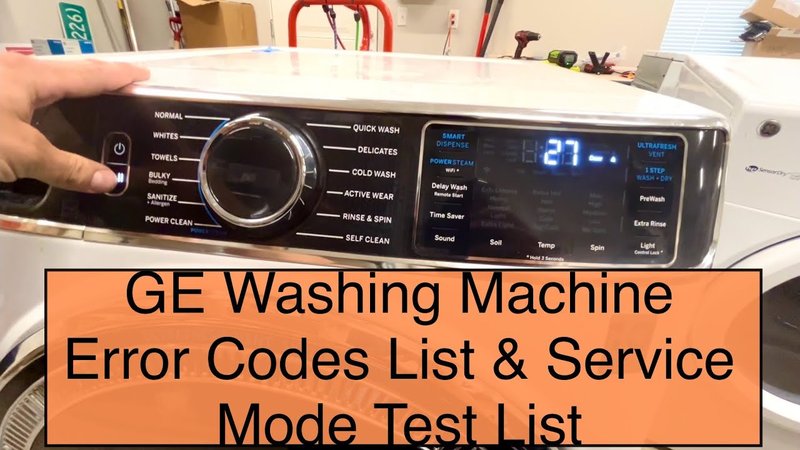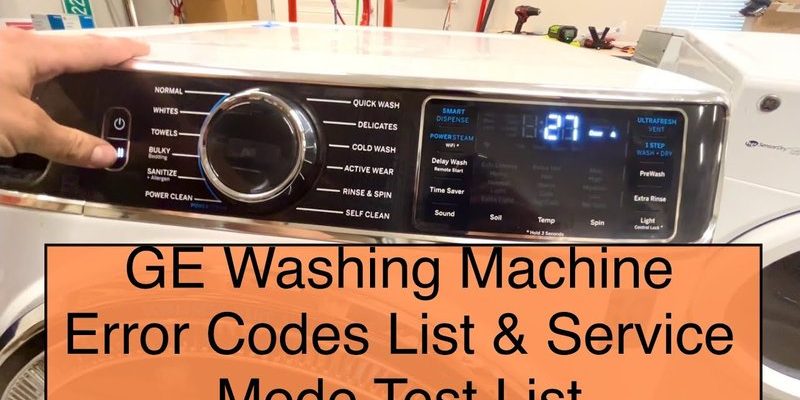
We’re going to break down what this error code signifies, why it shows up, and whether or not it’s something you can brush off. Think of it as deciphering a secret language that your washing machine uses to communicate its needs. When your GE washer flashes “UE,” it’s trying to tell you about a potential problem that’s often linked to something preventable, like how a car might ping you to fasten your seatbelt. Ready to dive in?
What Does Error Code UE Mean?
The “UE” error code on your GE washing machine is essentially its way of saying, “Hey, something isn’t balanced here!” Imagine trying to spin around in circles while standing on one leg – it’s a struggle to keep your balance, right? That’s how your washer feels when it detects an imbalance during the spin cycle. When the load inside isn’t evenly distributed, the drum wobbles excessively, which isn’t good for the machine.
This imbalance most often happens when you’ve loaded the washer with a mix of heavy and light clothing items. For instance, tossing in a big fluffy towel with a few lightweight shirts might seem harmless, but when they’re spinning rapidly, that towel can clump to one side. This causes the drum to become unstable, prompting the “UE” warning. The machine then slows down or stops spinning to prevent damage, just like how you’d stop spinning if you felt you were going to fall.
So, can you ignore this code? It might be tempting, especially if the machine seems to push through the cycle anyway. But consistently ignoring it isn’t wise. Doing so could lead to more significant mechanical issues down the line, much like how ignoring a tiny leak under the sink can lead to water damage. Instead, consider this code a gentle nudge to redistribute the clothes evenly. Give the drum a few spins by hand to see if that helps.
Common Causes of the UE Error Code
The most straightforward cause of the “UE” error is an uneven load of laundry. Imagine a seesaw with a child on one end and nothing on the other – it won’t function properly. The same principle applies inside your washing machine. When clothes bunch together on one side, it creates an imbalance that prevents the drum from spinning correctly.
Sometimes, the type of material can also contribute to this problem. Dense fabrics like jeans or heavy towels can become saturated with water and weigh much more than lighter items like t-shirts. During a spin cycle, these heavier items might clump together, exacerbating the imbalance. This is why it’s often better to wash items of similar weight together, ensuring they distribute more evenly in the drum.
Beyond the immediate load, other issues might trigger the “UE” code. For instance, if the machine isn’t level on the ground, it could sway or shimmy during operation, fooling the sensors into thinking there’s an imbalance. Consider using a level to check your washer’s stability and adjust accordingly. If leveling doesn’t solve the issue, there might be a mechanical fault such as a worn or broken suspension spring that requires professional attention.
Steps to Fix and Prevent the UE Error
The first line of defense against the “UE” error is ensuring your laundry is evenly distributed. If your washer signals an imbalance, pause the cycle, open the lid, and take a look inside. Manually redistribute the clothes throughout the drum. You could also remove some items if the load is too large, akin to easing up on an overloaded shopping cart.
It’s also wise to pay attention to your washer’s drum capacity. Overloading your machine is a common mistake – picture a backpack stuffed to the brim, making it hard to zip up. Overstuffing not only makes it challenging for the clothes to move freely, but it also increases wear and tear on the machine over time. Learning the right load size for your washer can save you a lot of hassle.
Additionally, regular maintenance can prevent the “UE” error from becoming a frequent occurrence. Clean your machine’s drum and check for any trapped debris that might affect its operation. Occasionally inspect your washer’s feet to ensure it’s stable and hasn’t shifted over time. You can think of it as regular check-ups that keep everything in tip-top shape.
When to Call for Professional Help
There are times when the “UE” error persists despite your best efforts. Much like a persistent cough that needs a doctor’s attention, your washer might require a professional if basic troubleshooting doesn’t resolve the issue. When your usual fixes fail, and the error becomes a regular problem, it might indicate a deeper mechanical issue.
Signs that you’d want to call in the experts include strange noises during the spin cycle or if the drum seems loose or off-kilter. These could signal underlying problems with the suspension springs or bearings that need professional know-how. Remember, attempting to fix complex issues without the right knowledge might lead to further damage.
Moreover, if your washer is relatively new, don’t hesitate to leverage the warranty. Most manufacturers offer repairs or replacements for defects within the warranty period. Just like you’d use a warranty on a new car for engine issues, the same applies here. It’s always better to let trained professionals handle intricate repairs, ensuring your washer is back to running smoothly.
So, while you might be tempted to brush off those “UE” codes, understanding and addressing them is crucial for the longevity of your machine. With a bit of care and attention, you’ll keep your laundry days trouble-free.
